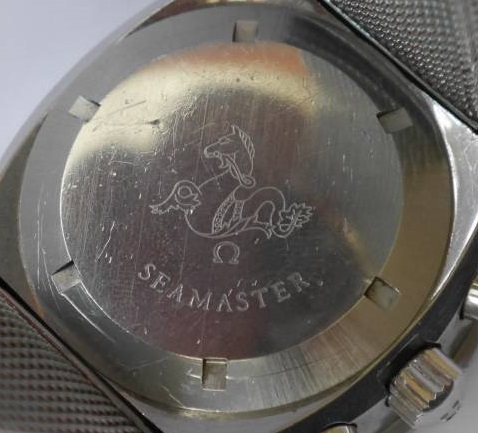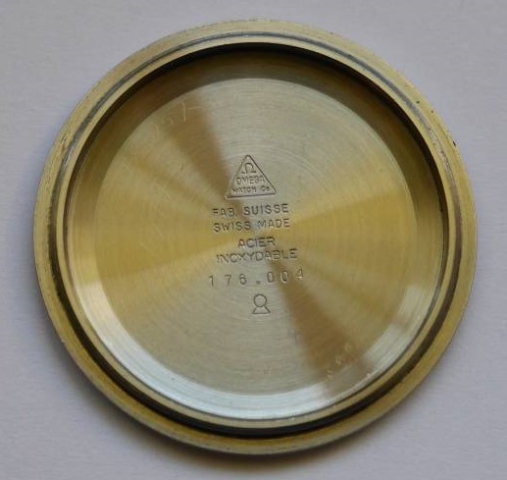General Description –
The Big Blue earned its nickname rightfully. It’s large, chunky, bold, and, well…very blue. It is also important – it is (maybe?) the world’s first self-winding diver’s chronograph, or so I understand. I’ve never been able to confirm that. I can confirm that it is the only Omega with either the cal. 1040 or cal. 1045 with a rotating bezel and screw-down crown. And after Omega stopped producing the Big Blue, they didn’t release another automatic diver’s chrono for about 20 years until the Bond-era Seamaster Professional chronograph.
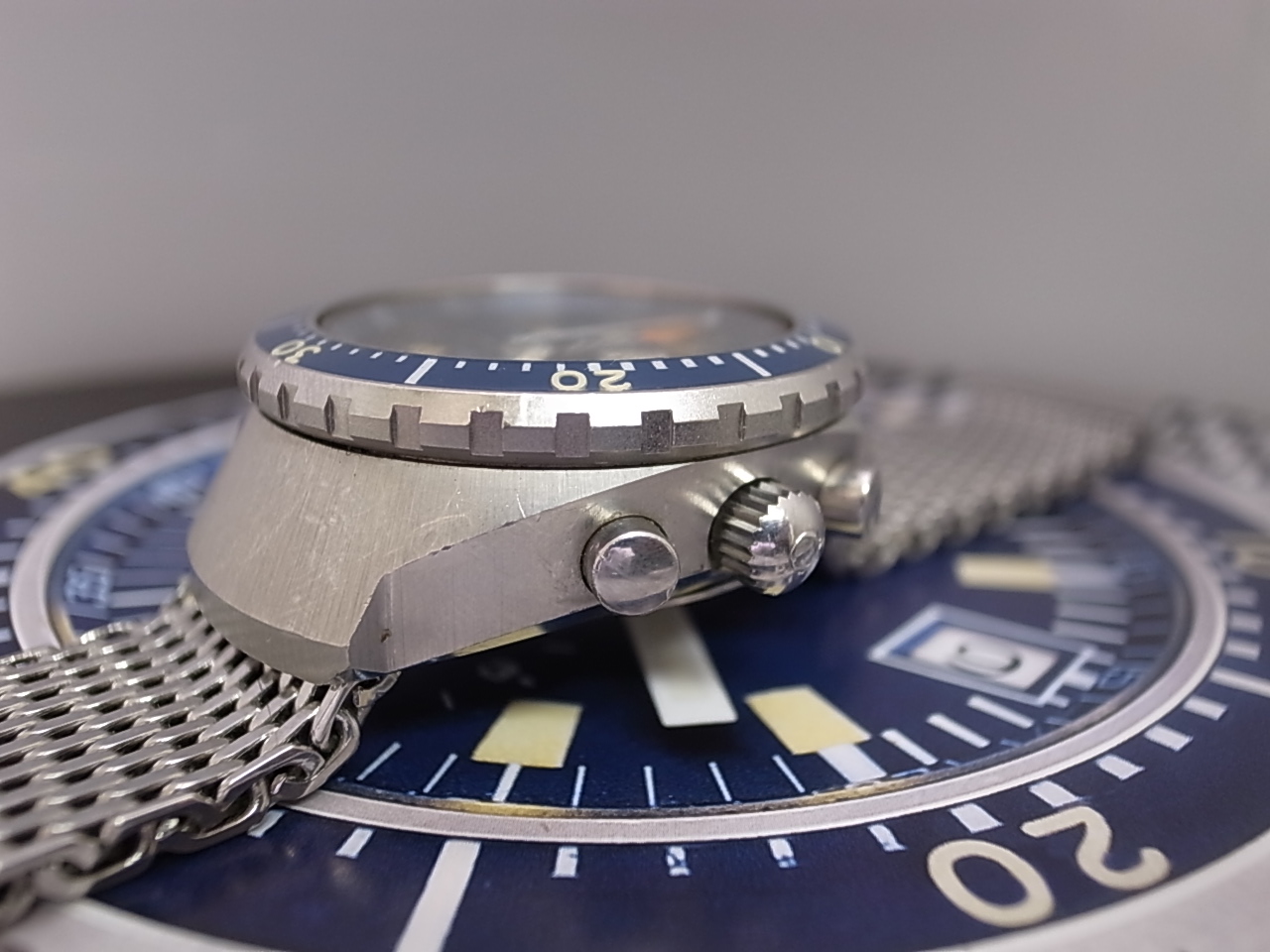
Like the Mark III and the flightmaster, it is one of the quintessential executions of the Omega “pilot-style” helmet-shaped case. Omega referred to the shape as “anatomic” in that it was designed for comfort to conform to the shape of the human wrist. In addition to the rotating outer bezel (for timing dives), it has a blue inner bezel too (fixed with a minute track and numerals every 5 minutes). The crown is arch-shaped and screws in which was an advanced feature at the time. A true diver, the dial is covered with large luminous hour markers and the chronograph minute hand is a bright orange.
A Journey Through Time refers to the lume as tritium but the dial has no Ts outside of “SWISS MADE”. So it might be some other luminous material. Either way, the dial has a lot of it, which added to underwater visibility for the professional divers that used this watch as an actual dive tool.
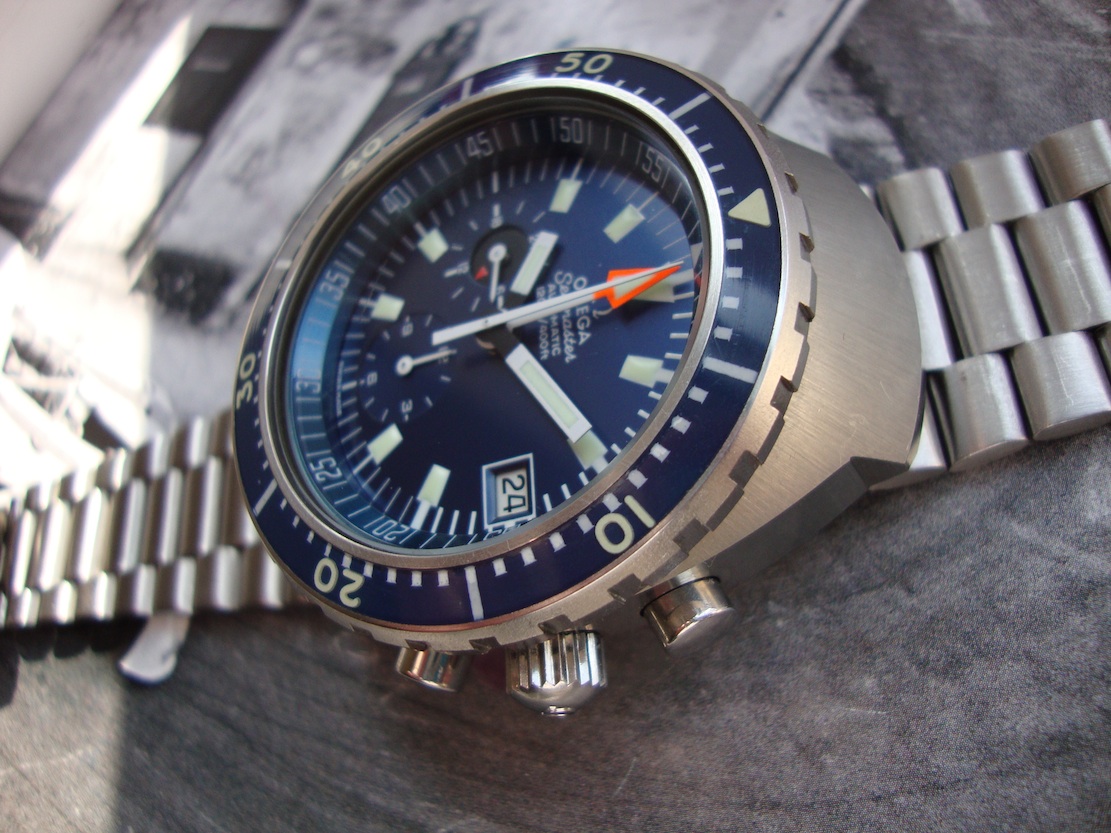
This case was only offered in steel, and it came on a number of straps including Isofrane, mesh, or the 1162 “flightmaster-style” bracelet.
Speedmaster Mark III Big Blue
AJTT famously features two dials for the 176.004 – one is the Seamaster that we see frequently, and one is the rarer Speedmaster Mark III dial. As far as I can see, the dials are nearly identical except of the text at 12 and the lack of “SWISS MADE” on the Mark III dial.
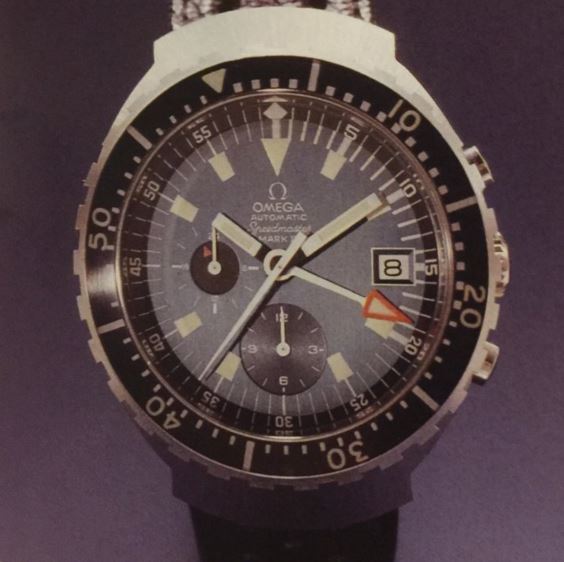
Digging through some old forum threads, it seems that until AJTT was published most collectors were unaware of the existence of the Speedmaster version of this dial. I’ve seen a couple other examples of the dial, one pictured by itself and one installed in the Mark III case, 176.002. Note that the one in the 176.002 has two levels of texture within the 6:00 subdial, while the other two examples are similar to the Seamaster dial in that it is flat after the recession at 6:00.
The perplexing quirk about the Speedmaster Big Blue is the lack of “SWISS MADE” at all. All three examples lack it. Looking through all the 1040/1041 photos I’ve saved the only other two (confirmed legitimate) dials that don’t have “SWISS MADE” anywhere on the dial are D1, a rare dial layout (I call it “SPAM” for the unique “Speedmaster AUTOMATIC MARK III text order) for an early pre-pro Mark III that is featured in most early Omega advertising but oddly I’ve never seen one photographed for sale or in anyone’s collection, and dial K1, the infamous dial seen only on the 176.001 depicted on the first cal. 1040 service manual.
I hate using the word “prototype” because it is thrown around far too often by ill-informed and/or unscrupulous eBay sellers to convince themselves or others that a redial or Franken is actually some valuable rarity. But it may be that all three of these are actual prototypes, and not production models. AJTT does occasionally show prototypes and when it does, it tends to label them as such. But in the case of the Speedmaster Mark III 176.004, it just refers to it as “very rare”. It could be that the lack of “SWISS MADE” is an indication of examples not manufactured for sale?
Whether a prototype or rarity, the Speedmaster dial isn’t frequently seen. I generally consider 176.004 as a Seamaster reference, and there is really only one correct dial style for it (Type F Dials). The hands and bezel are pretty straightforward for this reference when compared to other watches in the 1040 family, as there is really only one original configuration.
Caseback and Maker
For more information on casebacks, case manufacturers, and their maker’s marks, see the Caseback Collector’s Guide.
Maker: EPSA (diving bell symbol)
Caseback design: Larger lightly engraved Hippocampus logo, Omega symbol, SEAMASTER
Specs


Production Estimates, Dates & Serial Number Range
The Big Blue is a bit more common than one might expect. I estimate Omega made 7,000 of them. The production dates I’ve seen on Extracts are all from 1973 and 1974, with sales dates as late as December 1975.
Serial Numbers are concentrated towards the middle of the range, starting with 34,243,3XX and most as high as 36,259,1XX ( although there are a few outliers with 38 million and 40 million serials). There are also several batches that most Big Blues tend to come from. 34,254,XXX seems to be a batch that is nearly exclusive to this reference, as is 36,259,1XX (see highlighted below). There are other frequent sequences that aren’t exclusive to the reference that many Big Blues tend to come from (see collectors tips below).
**For more recent 176.004 serial number data, head over to the interactive serial number chart and filter by reference.


A note on Big Blue serial numbers: check out this thread, go to page two, and look for two posts by user “uwsearch”. He mentions the practice of certain service centers swapping out entire movements rather than repairing them for efficiency and estimates that maybe 30% of Seamaster divers from the period could have had their movements swapped during “service”. This implies that the serial numbers I’ve collected for Big Blues may be less accurate for this reference than others and some of these serials were originally attached to different references than what I observed them on. Despite this possibility, the Big Blues to tend to be pretty tightly clustered, and I’ve yet to observe a serial lower than 34,2XX,XXX or higher than 32,5XX,XXX.
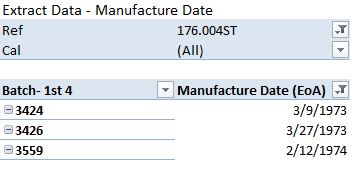

Collectors Should Look For
- Like the 176.002, “pilot” cases are easily scratched over time, and often that means that some well-meaning jeweler may have polished them in the past. Look for the original sunburst finish and sharp edges. Evidence of over-polishing is easy to spot via soft or rounded edges.
- The Big Blue is usually found with sunburst finishing on the steel case, radiating outward from an imaginary point at the center of the dial. It can occasionally be found with horizontal or circular brushing as well.
- Look for Type F dials. I believe any other dial to be a later replacement.
- Bezels are no longer made for the Big Blue by Omega. So finding a nice complete one for sale is going to be costly and may take patience. I don’t recommend buying a Big Blue missing a bezel as a project.
- The dials tend to show aging quite a bit. These were designed for professional divers after all, and often original dials show obvious evidence of water damage.
- Replacement/Service dials are very common, and don’t seem to impact value greatly. It can be tough to tell a more modern service dial from a clean original due to the lack of Ts on original dials. I tend to assume any dial or hands that don’t show obvious aging or patina to be modern.
- The lume painted on the dial should have faded either to a yellow or cream color. The more even the color, the better for value. Water damage often results in a black or green color to the lume, which is frequently unattractive or very uneven.
- Hands should be white except for the distinct orange and black paddle-shaped chrono minute counter. The handset in general is exclusive to this reference and easily distinguishable. The lume should be aged in color (yellow or cream).
- Prices tend to vary significantly but this is generally the most expensive reference of the family and has been for some time. This is probably due to the fact that it is the only dive watch of the family.
From My Collection
176.004 ST – Seamaster Diver’s Chronograph “Big Blue”
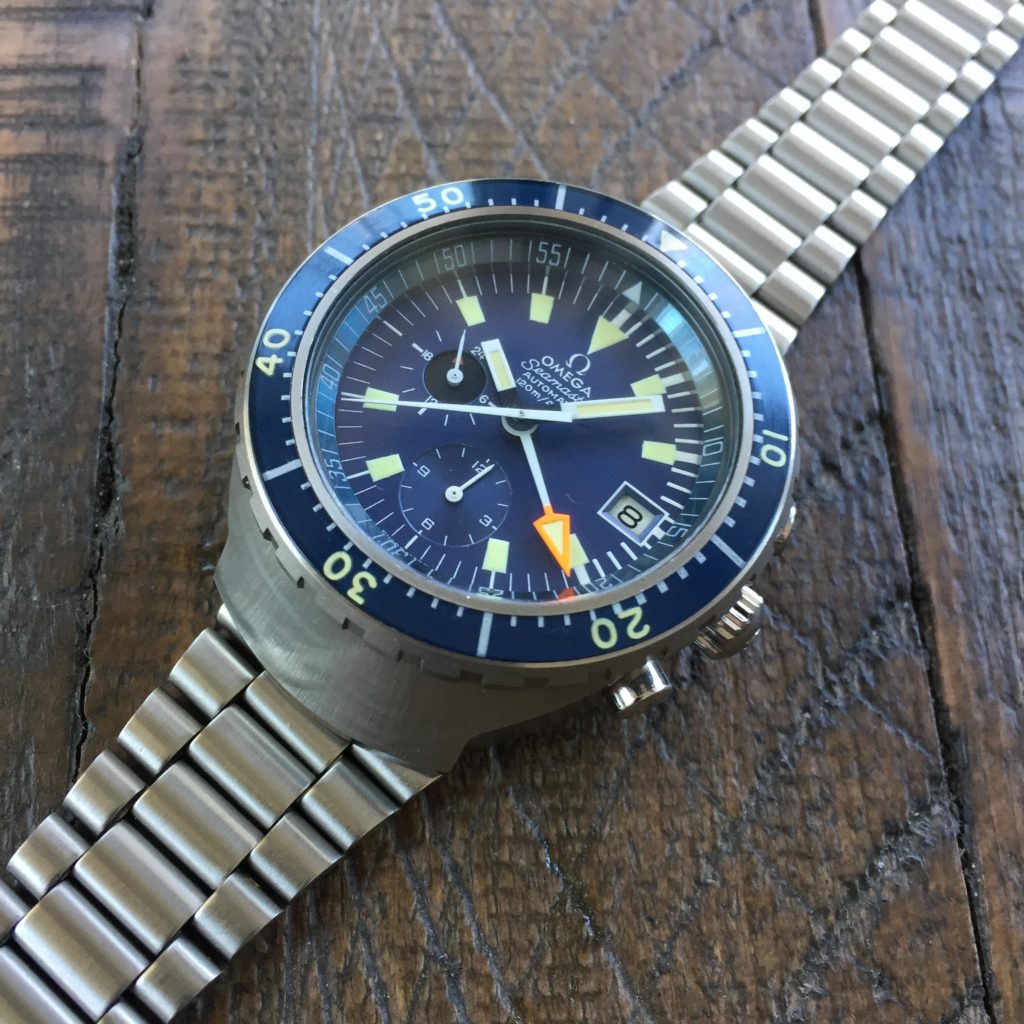

My Big Blue was described by the seller as all original, but I never bought into that. I had seen enough vintage dive watches to consider any examples in nearly pristine condition with a heavy dose of skepticism. I knew when buying this one it was likely a Bienne restoration, and I still believe that.
The case is either remarkably preserved or was expertly refinished with radial or sunburst brushing. The bezel lacks any nicks and the numerals, although a faded yellow, still have a decent glow. Same story with the F1 dial and hands. The hour markers have a decent amount of texture to them – which would suggest tritium, but the glow is pretty strong and green, which hints at luminova. That the dial just says “SWISS MADE” with no Ts, since this dial has never had Ts. So I cannot say with certainty if it is an original dial (least likely), an older service dial, or a modern service dial.
I did order an Extract for this watch, and disappointingly the Extract came back for a 176.007, meaning the case and the movement are not original to each other. It is possible that the entire movement was swapped out during a prior service, as was sometimes the practice.
All this adds up to a very nice looking watch that lacks originality. I still enjoy it and am glad I bought it a few years ago before prices started soaring.
This one also came on a 1162 bracelet.


